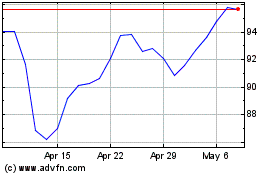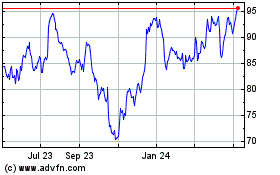By Liz Hoffman and David Benoit
The arrival of an activist investor in Morgan Stanley's stock is
both a validation of the strategy pursued by Chief Executive James
Gorman and a challenge to articulate and execute it better.
ValueAct Capital Management LP, a $16 billion hedge fund with a
penchant for high-profile turnaround stories, unveiled a $1.1
billion stake in Morgan Stanley on Monday and, in a letter to the
fund's own investors, showed support for Mr. Gorman's plan to move
the bank away from risky activities like trading and into more
stable areas like wealth management.
But if ValueAct CEO Jeffrey Ubben lauded the playbook, his view
on the stock price shows there is more work to do on the execution
of the plan. He said Morgan Stanley's transformation hasn't been
well understood or valued by investors, and though he laid that
blame at the feet of other investors, some still took it as subtle
criticism of the firm's salesmanship and a sign Mr. Gorman doesn't
have unlimited time to get the stock price rising.
"Should the company fall short of targets, we'd expect ValueAct
to hold Morgan Stanley management accountable," noted analysts with
Keefe, Bruyette & Woods in a Tuesday note. Then, Mr. Ubben's
firm "may take a more activist role."
While other activists often take aim at companies' balance
sheets, ValueAct is intently focused on senior management. Since
its founding in 2000, it has joined boards of at least 16 companies
that subsequently replaced their CEOs -- on some occasions with
input from ValueAct.
The firm often works behind the scenes with big investors to
force change even at large companies. Before taking a stake in
Microsoft Corp. in 2013, ValueAct privately rallied support for its
agenda among Microsoft's longer-term investors, The Wall Street
Journal has reported. ValueAct executives told asset managers, for
example, that they wanted a board seat at Microsoft and were
prepared to take aim at then-CEO Steve Ballmer, who ValueAct
believed had been slow to embrace new technologies. Mr. Ballmer
eventually left as CEO.
It is unclear to what extent ValueAct has reached out to Morgan
Stanley investors. And it doesn't always shake up the corner
office. Last year, it made a roughly $1 billion investment in
American Express Co., only to sell it a few months later after it
couldn't come to terms with management on how to spur the company's
growth.
Activists have typically avoided big banks, partly because their
ability to pay dividends and buy back stock -- popular activist
demands -- is limited by the Federal Reserve. Mergers, which
activists often encourage, have been effectively off limits for
larger institutions since the crisis.
Mr. Gorman, a 58-year-old former McKinsey & Co. consultant
who got the top Morgan Stanley job in 2010, made one of the bigger
acquisitions since the financial crisis when he engineered Morgan
Stanley's multiyear purchase of Citigroup Inc.'s wealth-management
arm, Smith Barney.
He has "evolved the business mix more aggressively than any
other large U.S. bank. That's a necessary but not sufficient recipe
for success," CLSA analyst Mike Mayo said. "Investors are getting
ever more restless."
Many banks have restructured in one way or another to become
simpler and more stable due to new regulations and pressure from
investors.
But shareholders haven't had much to show for it. Five of the
six biggest U.S. banks have traded below their book value this
year. Morgan Stanley's stock price has trudged mostly sideways
since 2009. Shares closed Monday at $29.66, 13 cents below their
close seven years ago. They rose 59 cents, or 2%, Tuesday to
$30.25.
Some things within Morgan Stanley's control have improved. Its
2015 net income of $6.1 billion more than quadrupled its 2009
effort, while revenue rose about 50%.
Still, return on equity, a key profitability metric, has lagged
far behind peers. In the fourth quarter of 2015, it was 4.4%, about
the same level it hit at the end of 2009.
Wealth management accounted for 43% of Morgan Stanley's revenue
last year, up from 24% in 2007. The bank is pushing to squeeze
higher profits from those clients, notably by opening up its
checkbook for personal loans.
Its wealth-management returns are almost freakishly steady. On
98% of days last year, the division booked between $50 million and
$70 million in revenue, according to a recent investor
presentation.
"Financials are really out of favor, and so the investor base is
stuck looking backward and not looking forward given what has
happened to Morgan Stanley's business mix," said Ricky Sandler,
founder and CEO of Eminence Capital, a $6 billion hedge-fund firm
that took a new stake in Morgan Stanley last quarter.
Eminence has gone activist before -- it launched a board fight
at what was then Men's Wearhouse in 2013 -- but supports the
management team and strategy at Morgan Stanley, which Mr. Sandler
called "a healthy franchise getting healthier."
Eminence owns about four million shares, Mr. Sandler said.
Mr. Ubben and ValueAct President G. Mason Morfit have said
investors are undervaluing that stability and instead punishing the
bank too harshly for weakness and inconsistent results in
fixed-income trading, an important source of Wall Street
profits.
Last quarter, after Morgan Stanley posted better-than-expected
results for fixed income, Mr. Gorman said there was "a general
overreaction to the underperformance" in the unit during the second
half of 2015.
Its original foray into wealth management was rocky. Morgan
Stanley bought Dean Witter in 1998, but the integration went poorly
for the business and it was viewed as a second-tier player before
Mr. Gorman was hired from Merrill Lynch to run it in 2006.
ValueAct would support the bank expanding its wealth-management
business, if done by acquiring accounts that have sensible costs,
one person familiar with the matter said.
The investor believes growth could come through technology
expansion into lower-wealth accounts, organically growing the
larger accounts or even acquisition, the person said.
(END) Dow Jones Newswires
August 16, 2016 19:46 ET (23:46 GMT)
Copyright (c) 2016 Dow Jones & Company, Inc.
Morgan Stanley (NYSE:MS)
Historical Stock Chart
From Mar 2024 to Apr 2024

Morgan Stanley (NYSE:MS)
Historical Stock Chart
From Apr 2023 to Apr 2024
